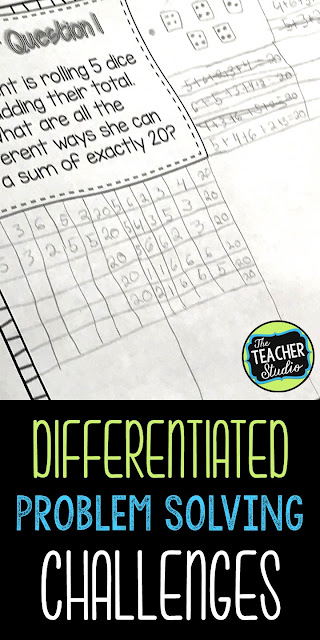I know so many of you have been looking for a way to build deep math thinking with your intermediate students–I know this because I get questions about it all the time!
You want your students to be challenged in new and interesting ways—and be easily able to differentiate so that ALL your students can benefit, right?
Here’s the problem…what’s challenging for some is way too tricky for others, right? Or you want to give a task–and you do–and then 1/3 of your class is finished in minutes and asking for more while others have barely gotten started. (Tell me that I’m not the only one this happens to!)
The first thing I wanted to do was to provide teachers and students with sets of quality math problems that not only get students thinking deeply and “doing” math—but talking about it as well. I wanted it geared for grades 3-5–knowing full well that different students in that age range have different skill sets. Because of this, I wanted to find something that would be perfect for differentiation as well—so for this, not all students need to do all three parts! In fact–for some of the challenges, we only do the first part. For other tasks, SOME students move on to other challenges.
Similarly, I wanted problems that could be done as a whole class warm up or with a smaller group, and because our curriculum is plenty full, I wanted something that would maybe last from 10-30 minutes but could be extended even more if the students are encouraged to talk and push their thinking. It’s always interesting to me how the timing of problems works out…sometimes what I think will be a quick task takes so much longer, but if the discussion is good and the students are engaged–it’s pretty hard to shut down the math, right?
How can I incorporate this type of problem solving into my math class?
I often get people asking me what a “typical” math class looks like in my room–and I have to be honest. THere is no such thing. I feel like I operate on a menu system…I have all these “tasty” things and I serve them up when I think it makes the most sense! That being said, here are a few suggestions for working these quality tasks into your day.
*Use as a “bell ringer” or warm up task. The goal of this should not be getting a correct answer, but the actual WORK of doing the problem solving! Each question has a starting point which can be used whole-class (you choose how much modeling/help) and then parts 2 and 3 can be used for everyone—or just for students who are ready! The colored slides are perfect to project from your computer…you can click to the next slides to show parts 2 and 3…but if students aren’t ready, no big deal! The original problem appears on every slide!
*Print and laminate and use as task cards at a problem solving station. These half-page cards are low ink and are perfect for math rotations, math workshop, guided math, or for fast finishers. Whether you do rotations or organize your stations differently, having quality problems ready to go really saves your time.
*Use as a reproducible problem-solving journal. I typed these problems up in a journal format with a full page of work space for the first part of the problem–with parts 2 and 3 copied on the next page. Copying the entire journal only takes 12 pieces of paper (without the cover) and is full of the 36 tasks. These can be used in so many ways—and even flexibly within a given classroom. I have some students who only do part of the collections–and others who might have the time and motivation to do much, much more.
*Consider using open-ended tasks as enrichment opportunities for students needing just a bit more. This is perfect–whether you have one student or a handful. They can work together, practice that accountable math talk, and push each other.
Problem solving is not easy!
Like many of my resources, this set of problems is certainly not meant to be a time filler! It is meant to be a rich and meaningful problem solving experience for you to use with your students. HOW you use it is up to you! I know we are all busy…but the time we invest in modeling some of the thinking and strategies needed with this type of problem REALLY pays off in the long run as students become more and more independent.
When I use tasks like this with MY students, there are a few things I like to make very clear and I think really contribute to building a culture for problem solving. One of the most important things that I think teachers need to keep in mind is that we often “overteach”. We TELL too much. We push our own strategies and ideas onto them–even if they aren’t quite ready for them. Before I used this problem with my students, I thought about how I would solve this as an adult–and then thought about what might get students off track. In this case…I did NOT want to show students my “boxes” (although for a few students I did coach them in this direction after they had worked awhile), but I DID want to make sure students understood the task–and the terms (like digits) so that they didn’t waste time. I didn’t TELL them what the task was…but students worked in pairs to make sense of it, then we came back as a whole group to discuss it and get on the same page.
Push Yourself!
Interested in checking out this set of problems? Just click HERE or the image below.
Want to pin this for later? Here you go!









